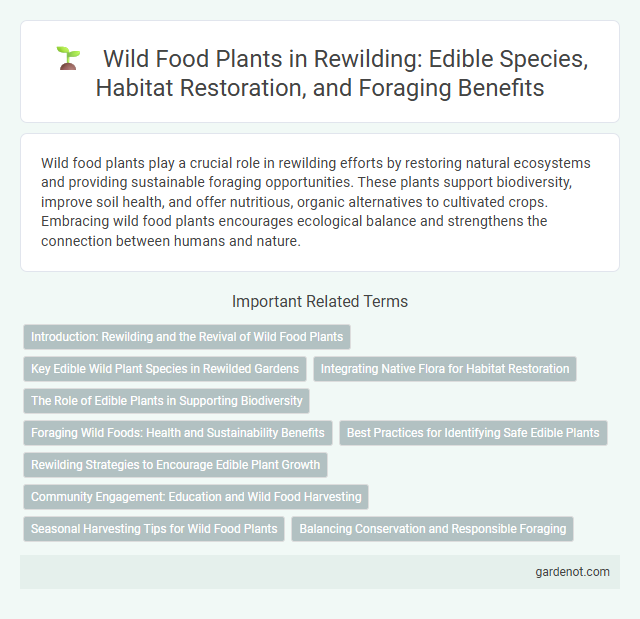Wild food plants play a crucial role in rewilding efforts by restoring natural ecosystems and providing sustainable foraging opportunities. These plants support biodiversity, improve soil health, and offer nutritious, organic alternatives to cultivated crops. Embracing wild food plants encourages ecological balance and strengthens the connection between humans and nature.
Introduction: Rewilding and the Revival of Wild Food Plants
Rewilding promotes the restoration of natural ecosystems, leading to the resurgence of wild food plants that offer rich biodiversity and nutritional benefits. These plants, often overlooked in modern agriculture, provide resilient sources of vitamins, minerals, and antioxidants crucial for sustainable food systems. Integrating wild food plants into diets supports ecological balance and reconnects communities with ancestral foraging traditions.
Key Edible Wild Plant Species in Rewilded Gardens
Key edible wild plant species commonly found in rewilded gardens include wild garlic (Allium ursinum), stinging nettle (Urtica dioica), and dandelion (Taraxacum officinale), all known for their nutritional benefits and culinary versatility. These plants support biodiversity by attracting pollinators and promoting soil health, making them essential components of sustainable foraging ecosystems. Incorporating native species like wild sorrel (Rumex acetosa) further enhances garden resilience and provides a continuous supply of nutrient-rich wild greens.
Integrating Native Flora for Habitat Restoration
Incorporating native wild food plants enhances habitat restoration by promoting biodiversity and supporting local ecosystems. These plants provide essential resources for pollinators, wildlife, and soil health, creating resilient and self-sustaining environments. Selecting species indigenous to the region ensures compatibility with existing flora and increases the success of rewilding efforts.
The Role of Edible Plants in Supporting Biodiversity
Edible wild plants play a crucial role in supporting biodiversity by providing essential habitats and food sources for a variety of insects, birds, and mammals. These plants contribute to ecosystem resilience by promoting genetic diversity and enhancing soil health through natural nutrient cycles. Incorporating wild food plants into rewilding projects fosters symbiotic relationships that sustain pollinators and wildlife populations, ensuring balanced and thriving ecosystems.
Foraging Wild Foods: Health and Sustainability Benefits
Foraging wild foods offers significant health benefits, providing nutrient-dense, organic sources rich in vitamins, minerals, and antioxidants often absent in commercial produce. Wild food plants contribute to sustainability by promoting biodiversity, reducing reliance on industrial agriculture, and supporting local ecosystems. Incorporating foraged wild plants into diets encourages environmental stewardship and helps maintain natural habitats.
Best Practices for Identifying Safe Edible Plants
Identifying safe edible wild food plants requires thorough knowledge of local flora, including clear understanding of toxic look-alikes and seasonal growth patterns. Employing field guides with detailed photographs and descriptions, combined with hands-on experience, enhances accuracy in plant recognition. Always perform a proper identification sequence such as the Universal Edibility Test to avoid harmful ingestion.
Rewilding Strategies to Encourage Edible Plant Growth
Rewilding strategies to encourage edible plant growth focus on restoring native ecosystems and reducing human intervention to promote natural regeneration of wild food plants like berries, nuts, and leafy greens. Techniques such as controlled grazing, selective tree thinning, and reintroduction of keystone species create favorable conditions for diverse edible flora to thrive. Enhancing soil health through minimal disturbance and composting further supports sustainable wild food plant proliferation.
Community Engagement: Education and Wild Food Harvesting
Community engagement in wild food plant rewilding enhances environmental awareness and sustainable harvesting practices. Educational programs teach identification, ethical foraging, and plant ecology, fostering local stewardship. Participatory wild food harvests connect communities to native biodiversity, promoting conservation through hands-on involvement.
Seasonal Harvesting Tips for Wild Food Plants
Seasonal harvesting of wild food plants requires identifying peak nutrient periods, typically during early spring for tender greens and late summer for fruits and nuts. Prioritize sustainable foraging by taking only what is needed and leaving enough to support plant regeneration and wildlife. Using proper tools and techniques, such as sharp scissors and gentle handling, helps maintain plant health and ensures consistent yields year after year.
Balancing Conservation and Responsible Foraging
Wild food plants contribute significantly to biodiversity and ecosystem health, supporting both wildlife and human nutrition. Responsible foraging practices, such as seasonal harvesting and species identification, minimize ecological impact while promoting sustainable use. Balancing conservation efforts with community engagement ensures wild plant populations remain resilient and accessible for future generations.
Wild food plant Infographic

 gardenot.com
gardenot.com